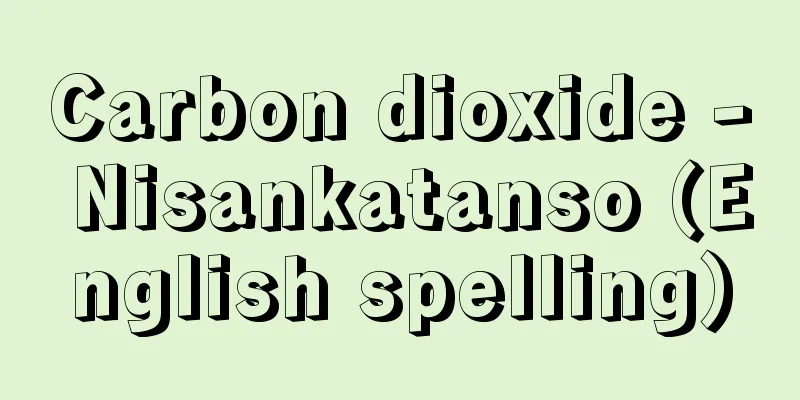Carbon dioxide - Nisankatanso (English spelling)

|
A gas produced during the complete combustion of carbon and its compounds, respiration of living organisms, and fermentation. Commonly known as carbon dioxide or anhydrous carbonic acid. It was Belgian scientist Van Helmont who recognized that the gas produced by charcoal combustion and the gas produced by fermentation are the same substance and named it gas sylvestre, but it was British scientist J. Black who investigated its chemical properties in detail. Black clarified that carbon dioxide is contained in the atmosphere and human breath, and that it becomes cloudy when absorbed by lime water, and that it fixes caustic alkalis to make them mild alkalis, and called carbon dioxide fixed air. Black's research marked the beginning of the so-called era of gas chemistry (about 50 years from the mid-18th century), which recognized the existence of gases with different chemical properties. Carbon dioxide makes up about 0.03% of the atmosphere by volume, and is produced in animal breath and fermentation, as well as in the combustion of carbon-containing substances and sometimes in volcanic eruptions. Liquefied carbon dioxide is called liquefied carbonic acid and is sold commercially in cylinders (the cylinders are green in color). Solid carbon dioxide is commercially available under the trade names solid carbon dioxide or dry ice. [Kenichi Morinaga and Katsunori Nakahara] Manufacturing methodIn the laboratory, it is generated using Kipp's apparatus from calcium carbonate (marble) and dilute hydrochloric acid. CaCO3 +2HCl→ CaCl2 + H2O + CO2 2NaHCO 3 →Na 2 CO 3 +H 2 O + CO 2 [Kenichi Morinaga and Katsunori Nakahara] natureIt is a colorless, odorless, non-flammable gas that is heavier than air. At about 2.5% in the air, it is impossible to light a candle. At 3-4% the human body loses its ability to move, and at 20-25% it goes into a state of suspended animation, but unlike carbon monoxide it is not inherently toxic. It is easily liquefied, and can be liquefied at room temperature at 50 atmospheres. Liquid carbon dioxide cannot exist stably at room temperature unless it is under pressure. If a canvas bag is placed over the mouth of a gas cylinder and the liquid carbon dioxide is blown out of the cylinder into the air, it will evaporate rapidly, absorbing the heat of evaporation and lowering the surrounding temperature, causing some of the liquid carbon dioxide to solidify, creating solid carbon dioxide like snow inside the bag. This is then poured into a mold and solidified to become dry ice. It is found in gases, liquids and solids. Its molecule is linear OCO with a CO distance of 1.16 Å (Å is angstrom, 10 -10 meters). This distance is much shorter than the expected value of 1.22 Å for a normal carbon-oxygen double bond (see the carbon dioxide resonance structure ). Carbon dioxide is a very stable compound, dissociating into carbon monoxide and oxygen at 2000 °C by only about 2%. It is reduced to carbon monoxide when passed over hot carbon, zinc or iron. Magnesium and alkali metals burn and release carbon when heated in carbon dioxide. It forms hydroxides and carbonates of alkali and alkaline earth metals. In calcium hydroxide, the carbonate CaCO 3 precipitates and reacts further with excess carbon dioxide to produce the soluble bicarbonate Ca(HCO 3 ) 2. This reaction with lime water is used to detect carbon dioxide. This reaction is also responsible for the dissolution and sedimentation of limestone in nature (such as in stalactites and stalagmites). Compared to other gases, carbon dioxide dissolves more easily in water, forming a solution of about 0.03 molar at room temperature and 1 atmosphere. Carbonic acid is produced in the aqueous solution (however, most of it is only loosely bound to water molecules and does not produce carbon dioxide), and the solution is acidic with a pH of about 4. When ammonia and carbon dioxide are reacted under high temperature and pressure, ammonium carbamate H 2 NCO 2 NH 4 is produced in the intermediate, and the reaction proceeds as follows: 2NH 3 +CO 2 →H 2 N・CO 2・NH 4 [Kenichi Morinaga and Katsunori Nakahara] ApplicationsThe most important uses are in the production of sodium carbonate, sodium bicarbonate (baking soda), white lead (basic lead carbonate), and in soft drinks such as soda water. Liquid carbonic acid is used as a fire extinguishing agent. Solid carbonic acid is an excellent refrigerant, suitable for the storage and transport of foodstuffs, fruit, etc. [Kenichi Morinaga and Katsunori Nakahara] MedicinalA type of respiratory stimulant. Carbon dioxide stimulates the respiratory center to induce inhalation. When the amount of carbon dioxide in arterial blood decreases, breathing rate decreases and peripheral blood vessels expand, resulting in a drop in blood pressure, an increase in heart rate, and a decrease in blood output. Carbon dioxide is a metabolic product of the body that is exhaled, but when it increases in arterial blood, the respiratory center becomes excited, breathing speeds up, and gas exchange is stimulated in an attempt to reduce the amount of carbon dioxide in the blood. In addition, when the concentration of carbon dioxide in the air is 3 to 5%, physiological effects appear, and when it exceeds 8%, people complain of difficulty in breathing, and when it exceeds 10%, people lose consciousness, and at 18% it is fatal. In addition, exhaled air contains about 4.4% carbon dioxide, and in the event of an attack of hyperventilation syndrome, the attack can be eliminated by covering the mouth and nose with a paper bag of several liters in size and breathing in the carbon dioxide in the exhaled air again. In addition, when inhaling oxygen, it is generally more effective to mix it with 5 to 10% carbon dioxide than to use oxygen alone. In addition, solid carbon dioxide (dry ice) is used as a caustic agent for skin diseases. [Fumiji Koho] "Carbon Dioxide - Chemistry, Biochemistry, and the Environment" edited by Shohei Inoue, Kei Izumii, and Koji Tanaka (1994, Tokyo Kagaku Dojin)" "Carbon Dioxide and the Global Environment" by Iwao Ohmae (Chuko Shinsho) [Supplementary Material] |©Shogakukan "> Resonance structure of carbon dioxide (figure) ©Shogakukan "> Volume of carbon dioxide that dissolves in 1 volume of water Source: Shogakukan Encyclopedia Nipponica About Encyclopedia Nipponica Information | Legend |
|
炭素とその化合物の完全燃焼、生物の呼吸や発酵の際などに生じる気体。俗称炭酸ガス、無水炭酸。炭の燃焼で生じる気体と発酵で生じる気体が同じ物質であることを認め、gas sylvestreとしたのはベルギーのファン・ヘルモントであるが、その化学的性質を詳細に調べたのはイギリスのJ・ブラックである。ブラックは、二酸化炭素は大気中あるいは人間の呼気中に含まれ、石灰水に吸収されると白濁を生じること、カ性アルカリを固定して温和アルカリとすることなどを明らかにして、二酸化炭素を固定空気fixed airとよんだ。ブラックの研究は、化学的性質の違う気体の存在を認める、いわゆる気体化学の時代(18世紀なかばから約50年間)の端緒となった。二酸化炭素は大気中容積で約0.03%含まれ、動物の呼気、発酵などでも生成し、また炭素を含む物質の燃焼、あるいは時に火山の噴気などに含まれる。液化したものは液化炭酸とよばれ、ボンベ詰め(ボンベの色は緑)として市販されている。固体二酸化炭素は固体炭酸またはドライアイス(商品名)とよばれ市販されている。 [守永健一・中原勝儼] 製法実験室ではキップの装置を用い、炭酸カルシウム(大理石)と希塩酸から発生させる。 CaCO3+2HCl→CaCl2+H2O+CO2 2NaHCO3→Na2CO3+H2O+CO2 [守永健一・中原勝儼] 性質無色、無臭、不燃性の気体で空気より重い。空気中に約2.5%含まれると、ろうそくに点火することができない。3~4%含まれると人間は活動能力を失い、20~25%になると仮死状態となるが、元来一酸化炭素と違って有毒ではない。液化しやすく、常温でも50気圧にすると液化する。液体二酸化炭素は常温では加圧下でなければ安定に存在することができず、ボンベの口にズックの袋をかぶせてボンベから液体炭酸を空気中に吹き出させると盛んに蒸発し、その際蒸発熱を吸収して周囲の温度が下がり、液体炭酸の一部が固化し、袋の中には雪のような固体炭酸ができる。これを型に入れて固めたものがドライアイスである。 気体、液体、固体中でつねに分子の存在が認められる。分子は直線形O-C-Oで、C-O距離は1.16Å(Åはオングストローム、10-10メートル)。この距離は普通の炭素‐酸素二重結合に対して期待される値1.22Åよりもかなり短い(二酸化炭素の共鳴構造の参照)。二酸化炭素は非常に安定な化合物で、2000℃で2%ぐらい一酸化炭素と酸素に解離するにすぎない。熱した炭素、亜鉛、鉄などの上を通すと一酸化炭素に還元される。マグネシウムやアルカリ金属は、二酸化炭素中で加熱すると燃えて炭素を遊離する。アルカリ金属やアルカリ土類金属の水酸化物と炭酸塩をつくる。水酸化カルシウムでは、いったん沈殿した炭酸塩CaCO3が過剰の二酸化炭素とさらに反応して可溶性の炭酸水素塩Ca(HCO3)2を生じる。この石灰水との反応は二酸化炭素の検出法に用いられる。また、自然界における石灰石の溶出や沈降(鍾乳(しょうにゅう)洞、石筍(せきじゅん)など)はこの反応による。他の気体に比べて二酸化炭素は水に溶けやすく、室温1気圧で約0.03モル溶液となる。水溶液中には炭酸を生じており(ただし大部分は水分子とゆるく結合しているだけであって炭酸を生成してはいない)、pH約4の酸性を示す。高温高圧下でアンモニアと二酸化炭素を反応させると、中間にカルバミン酸アンモニウムH2NCO2NH4を生じて次のように反応が進む。 2NH3+CO2→H2N・CO2・NH4 [守永健一・中原勝儼] 用途もっとも重要な用途は、炭酸ナトリウム、炭酸水素ナトリウム(重曹)、鉛白(塩基性炭酸鉛)の製造ならびにソーダ水などの清涼飲料水用である。液体炭酸は消火剤に用いられる。固体炭酸は優れた冷凍剤で、食料品、果物などの貯蔵、輸送に適している。 [守永健一・中原勝儼] 薬用呼吸興奮薬の一種。二酸化炭素は呼吸中枢を刺激して吸気作用をおこさせる働きをもつ。動脈血中の二酸化炭素の量が減少すると、呼吸数が減じ、末梢(まっしょう)血管の拡張がおこって、血圧低下、心拍数の増加と血液拍出量の減少がみられる。もともと二酸化炭素は呼気より排出される生体の代謝産物であるが、これが動脈血中に増加すると、呼吸中枢が興奮して呼吸が速くなり、ガス交換を盛んにして血中の二酸化炭素の量を少なくしようとする。また、空気中の二酸化炭素の濃度が3~5%になると生理的影響が現れ、8%を超えると呼吸困難を訴え、10%以上になると意識喪失がみられ、18%で致命的となる。 なお、呼気中には二酸化炭素が約4.4%含まれており、過換気症候群の発作時には数リットル程度の大きさの紙袋で口と鼻を覆って呼吸し、呼気中の二酸化炭素を再吸入することによって発作を消失させる。また一般に酸素吸入を行うときには、酸素単独よりも二酸化炭素を5~10%混ぜて用いたほうが有効である。このほか、固形炭酸(ドライアイス)は皮膚疾患の腐食剤として使われている。 [幸保文治] 『井上祥平・泉井桂・田中晃二編『二酸化炭素――化学・生化学・環境』(1994・東京化学同人)』▽『大前巌著『二酸化炭素と地球環境』(中公新書)』 [補完資料] |©Shogakukan"> 二酸化炭素の共鳴構造〔図〕 ©Shogakukan"> 水1体積に溶ける二酸化炭素の体積 出典 小学館 日本大百科全書(ニッポニカ)日本大百科全書(ニッポニカ)について 情報 | 凡例 |
<<: Nishi (spiny conch) - Nishi
>>: Selenium dioxide - Nisanka selenium
Recommend
Oceanography
The science of studying the ocean. Its research su...
Arc lamp
Although it is sometimes used as a general term f...
Yoshiyasu Kira
?-? A military commander in the Sengoku period. T...
Poynting-Robertson effect
This phenomenon is when interplanetary matter revo...
Norlund, E.
…Next, the relationship obtained from the definit...
stenokous
For example, reef-building corals that live in tr...
Uchiyamaga Residence
1722‐88 (Kyoho 7‐Tenmei 8) A kyoka poet of the mid...
Macacus ear
…The blunt projection sometimes seen on the poste...
Gendou's outrage - Gendou Hougen
A late Edo period research essay. Three volumes an...
Ghiorso, A.
…There are 14 known isotopes with mass numbers ra...
Missing rice - Kanmai
〘 noun 〙 Additional rice to make up for the loss c...
Shiga Prefecture
A prefecture in the northeastern part of the Kinki...
《Rush Chapter》
...It is a type of dictionary, thought to have be...
eight-oared shell with coxswain
...There are no regulations on the material or si...
Sochocho - Sochocho
A Chinese labor movement leader and Communist Par...









